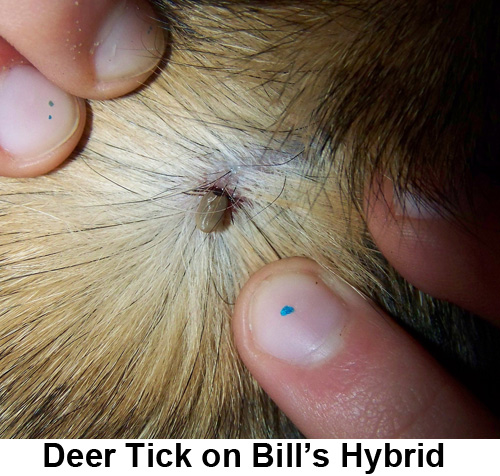Lyme Disease and the Deer Tick
May 2010
 In order to be infected with Lyme Disease you must first come in contact with the tick carrying the micro-organism called BORRELIA BURGDORFERI which is the cause of the disease. Certain areas of Ontario have shown to have more of the infected deer ticks than other locations. The area along the north shore of Lake Erie appears to have the highest population of infected ticks, averaging one infected tick for every 10 ticks found.
In order to be infected with Lyme Disease you must first come in contact with the tick carrying the micro-organism called BORRELIA BURGDORFERI which is the cause of the disease. Certain areas of Ontario have shown to have more of the infected deer ticks than other locations. The area along the north shore of Lake Erie appears to have the highest population of infected ticks, averaging one infected tick for every 10 ticks found.
Elsewhere in the province the incidence of infected ticks appears to be far lower. Therefore your chances of being bitten and infected, which takes upwards of 36 to 48 hours to occur before the disease is conveyed, is quite remote.
The symptoms of Lyme Disease can resemble those of various strains of the flu. In most cases early symptoms of the disease consist of stiffness of the joints, fever, headache, and a general feeling of lethargy. These symptoms are of course attributed to myriad ailments and therefore positive diagnosis of Lyme Disease can often be difficult. However the one most important symptom to look for if you are at all concerned, is the bull’s-eye shaped rash that appears from two to 32 days after being bitten. This rash can be quite small at first, about five centimeters, but can spread out to about 50 cm in circumference. This rash occurs in approximately 65 to 85 per cent of persons bitten. So, needless to say, this symptom is the most obvious one to look out for.
If the disease is not treated in its early stages, heart palpitations, irregular heart beat and various neurological defects can occur such as a slight trembling in the hands as well as a sagging of the eyelids. In advanced cases of the disease, physical complications and impairment can become fairly serious. In cases where the individual already has a compromised immune system, symptoms can be exacerbated. The good news is that usually, even in advanced cases, Lyme Disease can be treated with oral or intravenously administered antibiotics.
 A person can become infected with Lyme Disease simply by walking through a forested area and brushing against a twig or a blade of grass on which an infected tick is clinging. The tick waits for a passing host which in most cases is usually a deer or other animal, but in some cases can be a human. The tick attaches itself to the passing body and proceeds to a point where it can puncture the hosts skin and begin feeding on its blood. But here’s the catch; it takes the tick 36 to 48 hours of constant feeding before there’s imminent danger of the tick passing , or acting as a vector, for the disease. Therefore, after a days hike simply check yourself over thoroughly to ensure that you don’t have an uninvited guest hitching a ride.
A person can become infected with Lyme Disease simply by walking through a forested area and brushing against a twig or a blade of grass on which an infected tick is clinging. The tick waits for a passing host which in most cases is usually a deer or other animal, but in some cases can be a human. The tick attaches itself to the passing body and proceeds to a point where it can puncture the hosts skin and begin feeding on its blood. But here’s the catch; it takes the tick 36 to 48 hours of constant feeding before there’s imminent danger of the tick passing , or acting as a vector, for the disease. Therefore, after a days hike simply check yourself over thoroughly to ensure that you don’t have an uninvited guest hitching a ride.
Simple precautions will substantially minimize your risk of contracting this disease. The following are some of the most important ones.

Cats that are allowed to roam freely at all times run a much higher risk of picking up an infected tick than a cat kept indoors. The same goes for dogs that are not properly cared for and allowed to roam the countryside. Not only is it irresponsible to allow cats and dogs to roam freely but it can also be unhealthy for them and you if they happen to pick up an infected tick.
Although Lyme Disease should be a concern for anyone who enjoys the outdoors, it is not something to panic over. The disease here in Ontario is not nearly as well established as it is in parts of the U.S. Happy Hiking.

